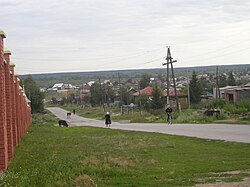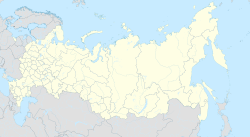Kolyvan, Novosibirsk Oblast
Urban-type settlement in Novosibirsk Oblast, Russia From Wikipedia, the free encyclopedia
Kolyvan (Russian: Колыва́нь) is an urban locality (an urban-type settlement) and the administrative center of Kolyvansky District of Novosibirsk Oblast, Russia, located on the Ob River 40 kilometers (25 mi) to the north of Novosibirsk. Population: 11,842 (2010 Census);[1] 10,947 (2002 Census);[4] 10,589 (1989 Soviet census).[5]
Kolyvan
Колывань | |
|---|---|
 View of Kolyvan | |
| Coordinates: 55.305°N 82.745°E | |
| Country | Russia |
| Federal subject | Novosibirsk Oblast |
| Administrative district | Kolyvansky District |
| Founded | 1797 (Julian) |
| Elevation | 123 m (404 ft) |
| Population | |
• Total | 11,842 |
| Time zone | UTC+7 (MSK+4 [2]) |
| Postal code(s)[3] | |
| OKTMO ID | 50621151051 |

History
Until the 1890s, Kolyvan was the commercial center of the surrounding area. During the construction of the Trans-Siberian Railway in the 1890s, there were plans to route the railroad through Kolyvan and Tomsk. However, Nikolai Garin-Mikhailovsky, the engineer responsible for routing the railroad in the area, decided that a site at the village of Krivoshchyokovo, some 40 kilometers (25 mi) upstream from Kolyvan, would be much more suitable for bridge construction: that was the only spot within the area where both the river banks and river bed were of solid rock; besides, the Ob floodplain is the narrowest there as way. Despite the protests of Kolyvan and Tomsk merchants, Garin-Mikhailovsky's southern route was approved by Alexander III in 1892.
The bridge was built at Krivoshchekovo; the new city of Novo-Nikolayevsk (later renamed Novosibirsk) arose around the bridge, and eventually became Siberia's largest city, meanwhile Kolyvan stagnated.
Culture
The majority of the log houses in Kolyvan are over two hundred years old, making the settlement a historical monument in itself.
Works by Kolyvan craftsmen are exhibited in the Hermitage Museum in St. Petersburg.
Local attractions include a museum of local history and a Russian Orthodox convent.
Architecture
- Krivtsov House
- Orlov House
- Krotkov House
Notable residents
- Vladimir Zhernakov was a Russian merchant, public figure and politician, serving as the first city head of Novonikolayevsk, from 1909 to 1914.
References
External links
Wikiwand - on
Seamless Wikipedia browsing. On steroids.












